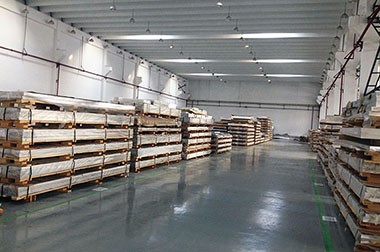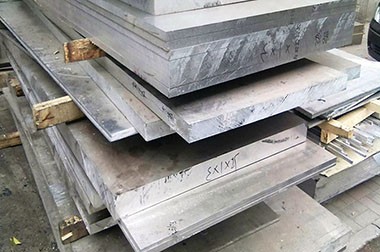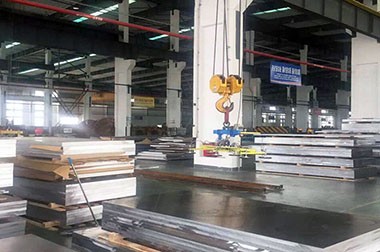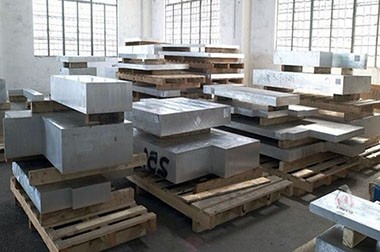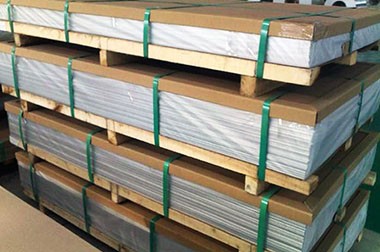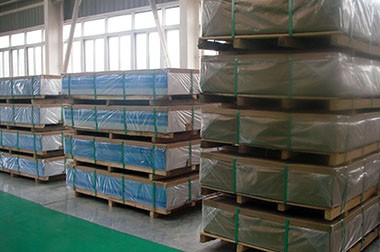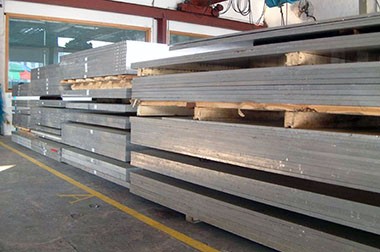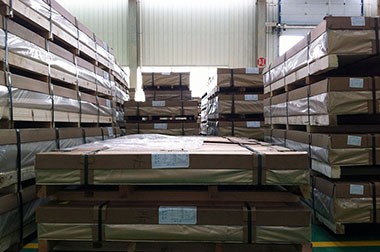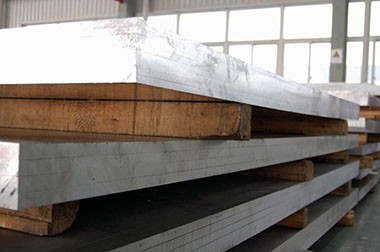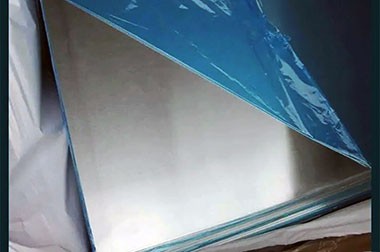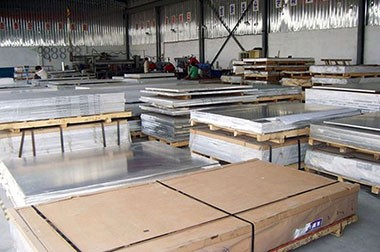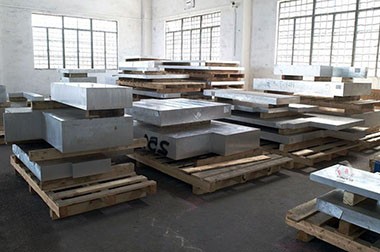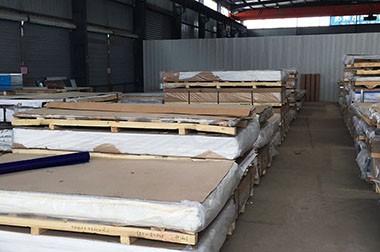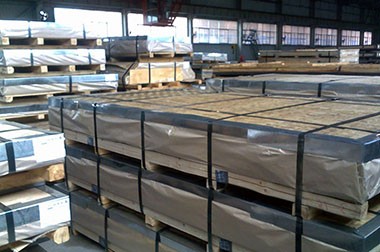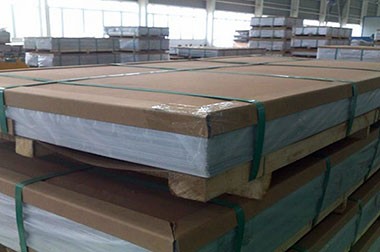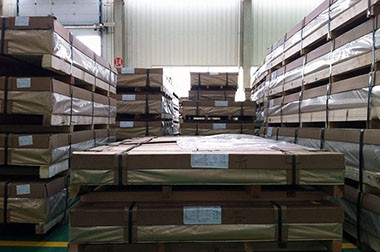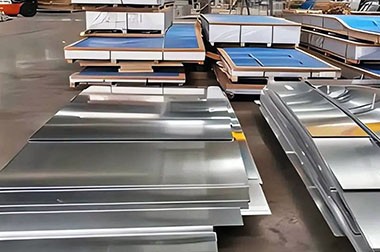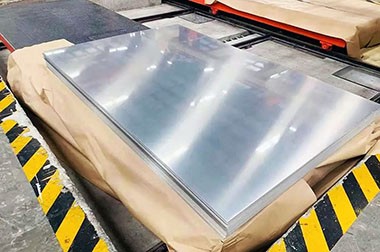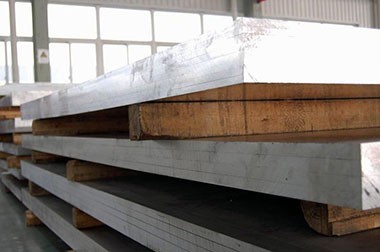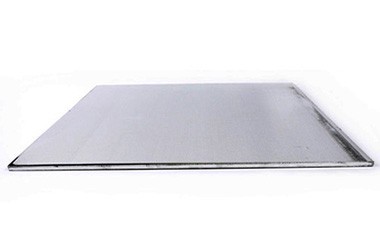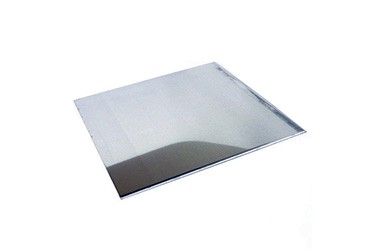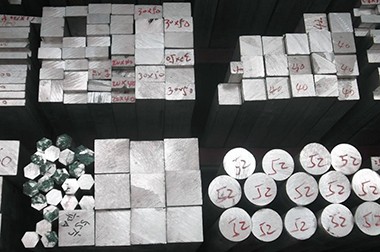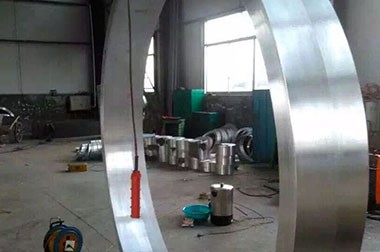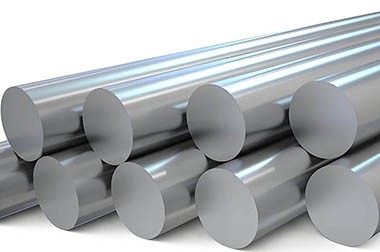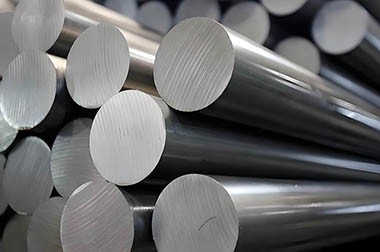2017 T3 T4 Aircraft Aluminum Sheet Plate
2017 aluminum alloy is a high-strength aluminum alloy with excellent strength and good machinability, commonly used in aerospace and military fields.
2017 aluminum has poor weldability but can be improved through heat treatment. Its corrosion resistance is relatively weak, and surface treatment is usually required to improve it. The final applications of this alloy include aircraft structural components, gears, and other parts requiring high strength.
2017 aluminum sheet is widely recognized for its balance between high strength and lightweight, making it an excellent choice for demanding industrial applications, especially in aerospace, automotive, and maritime fields.
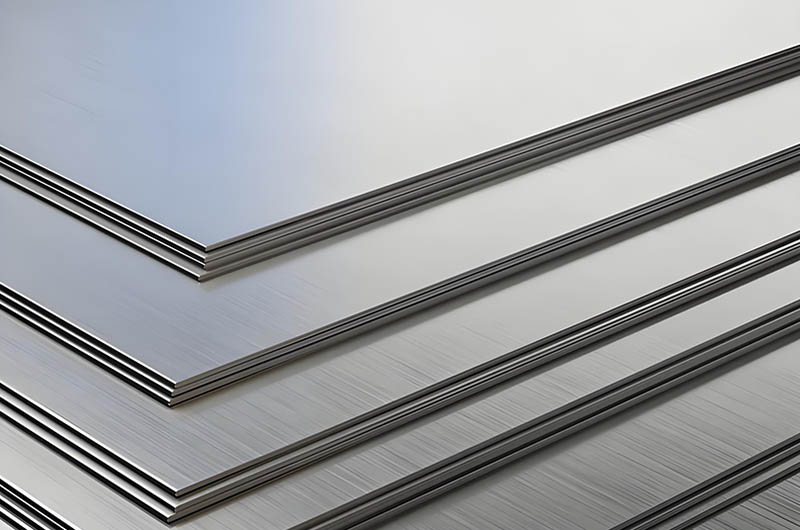
2017 aluminum is heat treatable and is known for its good machinability and medium corrosion resistance. It is commonly used in aerospace and military applications, often coated or treated to enhance durability.
2017 aluminum alloy is a heat-treatable high-strength aluminum alloy belonging to the aluminum-copper-magnesium series (2xxx series). It has good strength, ductility, and machinability, higher strength than 2011 aluminum alloy, and also exhibits excellent corrosion resistance, fatigue resistance, and machinability. These properties make 2017 aluminum widely used in aerospace, military, automotive, and structural engineering fields, especially for parts that require high strength and lightweight properties.
In the aerospace field, 2017 aluminum alloy is commonly used to manufacture aircraft structural components such as wing ribs, fuselage frames, and landing gear. These parts need to withstand high stresses and fatigue, making the high strength and excellent machinability of 2017 aluminum the ideal choice. 2017 aluminum is also used in the production of engine components, suspension systems, and other parts subject to high stresses, effectively improving fuel efficiency and performance.
2017 aluminum alloy shows good machinability during processing, ensuring manufacturing efficiency and precision, making it particularly suitable for the production of complex parts with precise dimensions. However, its welding performance is inferior to other aluminum alloys, especially in arc welding, where the welding process can reduce its corrosion resistance. Therefore, 2017 aluminum alloy is typically not used for welding applications but is more suitable for resistance welding technology.
After heat treatment (such as solution heat treatment and age hardening), the performance of the alloy is further enhanced, with yield strength and tensile strength significantly increased, allowing it to compete with certain high-strength steel alloys at lower densities.

2017 aluminum advantages
- Lightweight: Density is about 2.79 g/cm³.
- High strength: 2017 aluminum has high strength, comparable to many steel alloys, especially at temperatures above 125°C, where its strength is superior to 7075 aluminum alloy.
- Excellent machinability: The alloy is easy to form, cut, and drill, maintaining good mechanical properties.
- Heat treatment capability: Through heat treatment, the strength and hardness of 2017 aluminum can be significantly improved.
- Corrosion resistance: Compared to other aluminum alloys, 2017 aluminum alloy has good corrosion resistance, extending the product's lifespan.
- High strength-to-weight ratio: Helps improve performance and efficiency.
- Excellent machinability: 2017 aluminum is ideal for manufacturing precision parts.
- Good fatigue resistance: 2017 aluminum is suitable for components subjected to cyclic loads.
These characteristics make 2017 aluminum widely used in aircraft structures, rivets, truck hubs, propeller parts, and other high-strength structural components. Additionally, 2017 aluminum is commonly used in the manufacture of military equipment, mechanical components, transportation vehicles, and some high-performance engineering structural parts.
2017 aluminum alloy is a high-performance, widely applicable medium-strength forged alloy, particularly suitable for manufacturing high-strength structural parts and high-stress components.
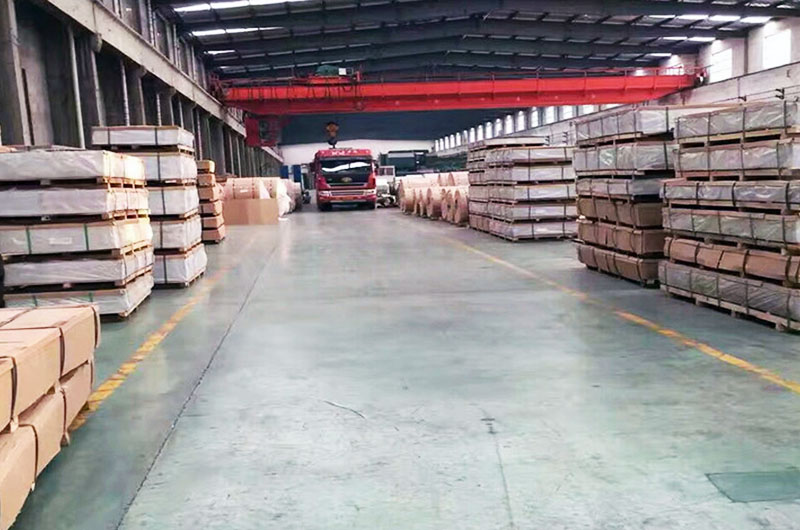
2017 Aircraft Aluminum Sheet Plate Size
| Alloy | Temper | Thickness(mm) | Width(mm) |
| 2017 | T4/T3 | 0.3-4.0 | 1000-2600 |
2017 T3 T4 Aircraft Aluminum Sheet Plate Standards
- ASTM B209: Aluminum sheet/plate standard.
- AMS 4120: Aerospace material specification.
- QQ-A-250/3: Federal specification for 2017 alloy.
2017 aluminum corrosion resistance
2017 aluminum alloy has poor corrosion resistance, mainly due to its high copper (Cu) content, which makes it susceptible to electrochemical corrosion and stress corrosion. This alloy may experience localized corrosion when exposed to humid or electrolyte-rich environments, especially when subjected to mechanical stress or in contact with different metals.
By employing solutions such as aluminum cladding protection, anodizing, coating protection, alloy optimization, and avoiding dissimilar metal contact, the corrosion resistance of 2017 aluminum alloy can be significantly improved, making it widely used in aerospace, aviation, and marine fields, ensuring long-term reliability in harsh environments.
| Solution | Description | Application |
| Aluminum cladding (pure aluminum layer) | A layer of pure aluminum is applied to the surface of 2017 aluminum alloy to provide an additional protective layer, preventing corrosion media from contacting the alloy substrate. | Marine, aerospace, industrial equipment, and other high-corrosion environment applications. |
| Anodizing | Electrochemical treatment forms a dense aluminum oxide film, providing additional corrosion resistance, hardness, and wear resistance, while improving appearance. | Aerospace, construction, industrial applications, especially where appearance and corrosion resistance are required. |
| Coating protection | Use of corrosion-resistant coatings (such as anti-corrosion paint or spray coating) to isolate the aluminum alloy surface from the external environment, preventing moisture and oxygen from penetrating. | Marine environments or other high-corrosion environments for aluminum alloy components. |
| Alloy combination | Combining with other corrosion-resistant alloys (such as manganese or silicon-rich alloys) to improve overall corrosion resistance. | Complex parts requiring both high strength and good corrosion resistance, such as aerospace components. |
| Avoid contact with dissimilar metals | Avoid direct contact between 2017 aluminum alloy and other metals to prevent electrochemical corrosion. Insulation pads or coatings can be used for isolation. | Aircraft and other equipment, particularly in high-end complex parts. |
2017 Aluminum Standards and Equivalents
- ASTM:B209 (Standard Specification for Aluminum Sheets and Plates).
- AMS:4172 (Aerospace Material Standard).
- EN:AW-2017A (European designation).
- Similar alloy: 2024 (Higher Mg content; higher strength but poorer machinability).
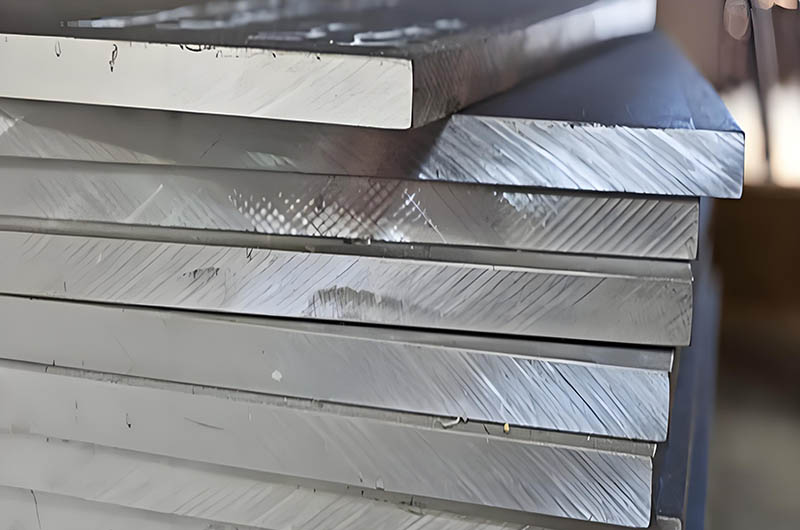
Characteristics of 2017 Aircraft Aluminum Plate
- 1. High Strength: 2017 aluminum alloy has a higher strength than many other aluminum alloys, making it suitable for bearing high loads.
- 2. Good Workability: After heat treatment, 2017 aluminum alloy can be formed using various processing methods, making it suitable for manufacturing complex-shaped components.
- 3. Corrosion Resistance: While aluminum alloys generally have good corrosion resistance, 2017's corrosion resistance is relatively poor and typically requires surface treatments (such as anodizing) to enhance its corrosion resistance.
- 4. Weldability: The weldability of 2017 aluminum alloy is average, requiring special attention during welding, and usually employs specific welding techniques and materials.
2017 Aluminum Tempers
2017 T3 Aluminum Plate
The 2017-T3 aluminum plate is an aluminum-copper-magnesium alloy, known for its high strength and good heat resistance, making it suitable for applications in high-temperature environments. It undergoes heat treatment (such as age hardening) to enhance its strength, allowing it to operate below 150°C, and its strength can surpass that of 7075 aluminum alloy at temperatures exceeding 125°C. It is commonly used in aerospace, military equipment, and mechanical components that require high strength and high-temperature resistance.
2017 T4 Aluminum Plate
The 2017-T4 aluminum plate is an aluminum alloy that has undergone solution treatment followed by natural aging or low-temperature aging. It has good formability and fatigue resistance. Although its strength is slightly lower than that of the T3 state, it offers improved ductility and plasticity, making it suitable for applications requiring good formability and strong fatigue resistance, such as non-load-bearing components in aerospace, automotive body structures, and building structural components.
2017 Aluminum available in various forms
Aluminium Alloy 2017 A is available in Sheet, Plate, Wire, Tube, Rod and Bar
- Form: Plates, Sheets, Bars, Rods.
- Thickness: Typically 6 mm to 150 mm (varies by supplier).
- Surface Treatment: Rolled surface, Alclad, or anodized.
Aluminum alloy 2017A is a heat-treatable, wrought alloy known for its high strength and excellent fatigue resistance. It is commonly used in aerospace and structural applications. This alloy is available in various forms, including:
| Form | Image | Application |
| 2017 Aluminum Sheet and Plate |
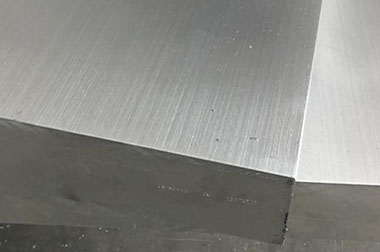
|
Suitable for high-strength structural components |
| 2017 Aluminum Rod and Bar |
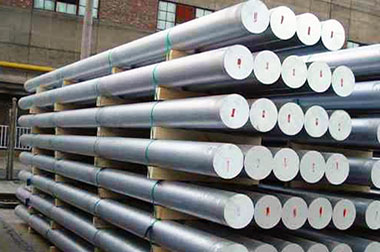
|
Ideal for manufacturing high-strength forged parts |
| 2017 Aluminum Wire |
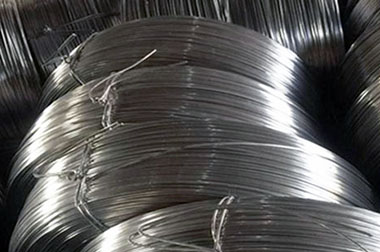
|
Utilized in applications requiring high mechanical properties |
| 2017 Aluminum Tube |
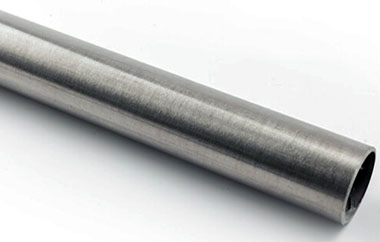
|
Applicable in the aeronautical industry for parts subjected to high stresses |
2017 Aircraft Aluminum Sheet Plate Mechanical Properties
| Alloy | Temper | Thickness(mm) |
Tensile Strength Rm(Mpa) |
Yield Strength RP0.2(Mpa) |
Breaking Elongation A50% |
Standard |
| 2017 | T4 | 0.3-3.5 | 395-405 | 255-270 | 19-23 |
GB/T3880 EN485 ASTM B209 |
What is the composition of aluminum 2017?
| Alloy | Si | Fe | Cu | Mn | Mg | Ni | Cr | Zn | Ti | Standard |
| 2017 | 0.2-0.8 | 0.70 | 3.5-4.5 | 0.4-1.0 | 0.4-0.8 | - | 0.10 | 0.25 | 0.15 |
GB/T3190 EN573 ASTM B209 |
2017 Aluminum Equivalent
UNS A92017, ISO AlCu4MgSi, Aluminium 2017, AA2017, Al2017
Machinability and Formability of 2017 Aluminum
2017 aluminum has excellent machinability, especially in the T4 condition, making it an ideal choice for precision parts. Its good formability allows it to be shaped into complex configurations; however, welding is more challenging due to the elastic oxide layer on its surface, often requiring specialized techniques or alternative joining methods.
Applications of 2017 Aircraft Aluminum Plate
Due to its excellent strength and rigidity, 2017 aluminum alloy is widely used in the aerospace field.
1. Aircraft Structural Components
- Fuselage Frames: 2017 aluminum alloy is used to manufacture the frame structures of aircraft fuselages, providing necessary strength and rigidity.
- Wings: Load-bearing components in wing structures commonly use 2017 aluminum alloy to ensure they can withstand the loads during flight.
2. Fasteners and Supports
- Rivets and Fasteners: Many aircraft fasteners (such as rivets and bolts) are made from 2017 aluminum alloy to enhance connection strength and stability.
- Brackets and Support Structures: Inside the aircraft, 2017 aluminum alloy is used to manufacture various brackets and support structures to ensure safe securing of equipment and systems.
3. Wing Panels and Skin
Skin Materials: The external skin of aircraft wings commonly uses 2017 aluminum alloy, capable of withstanding aerodynamic loads while maintaining a lightweight.
4. Landing Gear
- Landing Gear: Some landing gear components use 2017 aluminum alloy to ensure sufficient strength and durability during landing and takeoff.
- Control Surfaces: Certain components in ailerons and rudders also utilize 2017 aluminum alloy.
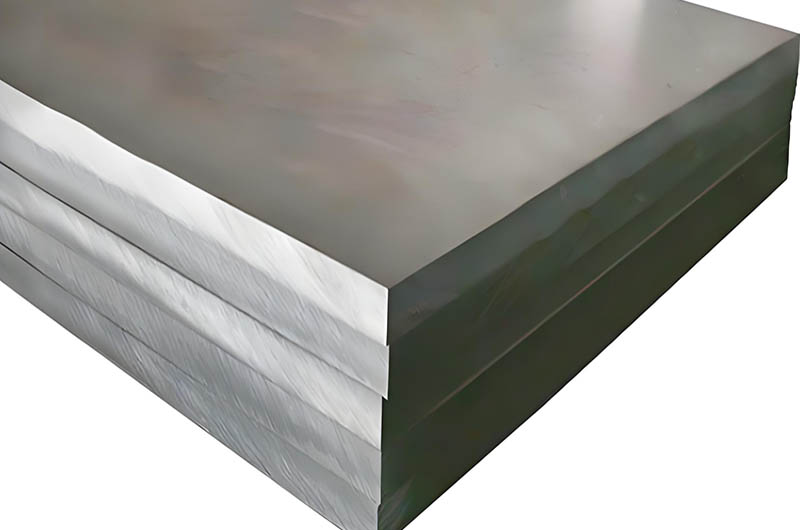
More information on 2017 aluminum plate
| Property | Details |
| Principal Design Features | Heat treatable (age-hardening) alloy with intermediate strength and good ductility. |
| Applications | 2017 commonly used in screw machine products, fittings, pulleys, gauges, coat hangers, and crochet and knitting needles. |
| Machinability | Very good in T4 temper; less good in annealed condition. Best to machine in T4 temper with oil lubricants recommended. |
| Forming | Very good formability, especially in annealed state (O temper). Can be formed in T4 temper, but not as easily as in O temper. |
| Welding | May be welded but heat will reduce corrosion resistance. Welding should be avoided unless heat treatment after welding is possible to restore corrosion resistance. Sensitive to cracking. Inert gas and resistance welding are recommended. |
| Heat Treatment | - Solution anneal at 940°F for 3–4 hours, then water quench. - Age hardening occurs at room temperature to produce T4 temper. - O temper: 775°F for 3 hours, controlled cooling, then air cool. |
| Cold Working | Cold working (e.g., shaping, bending) is easily accomplished by conventional means, best in T4 temper. |
| Annealing | Anneal at 775°F for 3 hours, then controlled cooling at 50°F per hour down to 500°F, followed by air cooling. |
Why Choose Haomei Aluminum as Your Supplier for AA 2017 Aluminum Plate?
We have extensive experience in the manufacturing, stocking, and supply of 2017 aluminum plates.
We offer the best prices for 2017 alloy aluminum plates, with global supply and the shortest delivery times.
We can provide factory delivery, FOB, CFR, and CIF shipping to any port.
Haomei Aluminum provides documentation including certificates of origin, invoices certified by the chamber of commerce, PL, test certificates in accordance with EN 10204 3.1, and other test reports (as per customer requirements).
2017 Aluminum Limitations
- Corrosion: Requires protective coating in harsh environments.
- Formability: Less suitable for complex forming compared to 5xxx or 6xxx alloys.
- Availability: Somewhat replaced by newer alloys (such as 2024), but still used in niche applications.
- Welding: Challenging, requires specialized techniques.
- Reduced corrosion resistance: Compared to some other alloys.
- Higher cost and processing requirements: More expensive and requires special processing.
- Processing and forming challenges: Surface damage can occur; careful handling is necessary.
- Heat and structural limitations: Lower thermal conductivity and strength compared to some metals.
These considerations are important when selecting materials for specific applications.
2017 Aluminum Processing and Manufacturing
- Machinability: Excellent; suitable for high-speed machining.
- Formability: Moderate; lower ductility compared to 6xxx alloys.
- Welding: Challenging due to cracking risks; requires post-weld heat treatment if welded.
- Heat treatment: Solution treated at around 500°C, then aged to enhance strength.
- Machining: Excellent; produces smooth surfaces.
- Heat Treatment: Solution treatment (T4) for optimal strength.
2017 aluminum sheet offers high strength and excellent machinability, making it an ideal choice for aerospace and mechanical applications. With protective treatments and careful application design, its limitations in corrosion resistance and formability can be mitigated.
Comparison of 2017 Aluminum with Other Alloys
2017 Aluminum Sheet Comparison
- 2024: Higher strength, better fatigue resistance; more commonly used in modern aerospace.
- 7075: Higher strength (zinc-based), but lower corrosion resistance.
- 6061: Better corrosion resistance, but lower strength (Mg-Si alloy).
Which is more expensive?
| Aluminum Sheet Model | Price Level | Main Reason |
| 7075 Aluminum Sheet | Most Expensive | High zinc content and complex processes lead to the highest cost |
| 2024 Aluminum Sheet | Second Highest | High copper content, processing and corrosion protection raise the price |
| 2017 Aluminum Sheet | Medium | Copper-magnesium alloy, cost is lower than 2024 but higher than 6061 |
| 6061 Aluminum Sheet | Cheapest | Magnesium-silicon alloy, low raw material and processing costs |
What are the pros and cons of each?
| Aluminum Alloy Model | Advantages | Disadvantages |
| 7075 Aluminum Alloy | Higher Strength: Tensile strength is significantly better than 2017. | Worse Corrosion Resistance: Requires additional surface treatment, 2017 has relatively weak corrosion resistance. |
| Better Fatigue Resistance: Suitable for dynamic load scenarios (e.g., aircraft landing gear). | Higher Cost: 30% to 50% more expensive than 2017. | |
| More Difficult to Process: Extremely poor weldability, whereas 2017 can be partially welded (requires special processes). | ||
| 2024 Aluminum Alloy | Slightly Higher Strength: Tensile strength is slightly better than 2017. | Worse Corrosion Resistance: 2024 requires strict corrosion coatings, while 2017 is easier to maintain. |
| Better Fatigue Resistance: Suitable for long-term high vibration environments (e.g., aircraft skins). | Slightly Higher Cost: 10% to 20% more expensive than 2017. | |
| Similar Weldability: Both are difficult to weld and require rivets or bolt connections. | ||
| 2017 Aluminum Alloy | Moderate Strength, Suitable for General High Load Structures (e.g., rivets, brackets). | Poor Corrosion Resistance: Requires anodizing or coating protection, not as good as 6061. |
| Better Machinability: Easier to cut and form than 2024/7075. | Limited Weldability: Requires inert gas shielded welding (e.g., TIG welding). | |
| 6061 Aluminum Alloy | Excellent Corrosion Resistance: Can be used in wet environments without additional protection (e.g., ship components). | Significantly Lower Strength: Cannot replace 2017 in high load scenarios. |
| Better Machinability: Easier to weld, forge, and costs 20% to 30% less than 2017. | Poor Fatigue Resistance: Easily deforms under long-term dynamic loads (e.g., unsuitable for aircraft structures). |
Material Selection Recommendations
| Requirement Scenario | Recommended Aluminum Alloy | Reason |
| Replacing 2017 for High Strength Requirements | 7075 or 2024 | 7075: Suitable for extreme strength scenarios (e.g., aircraft landing gear), tensile strength is higher. |
| 2024: Suitable for scenarios balancing strength and cost, tensile strength is slightly higher than 2017. | ||
| Replacing 2017 for Corrosion Resistance Requirements | 6061 | Sacrificing some strength for corrosion resistance and lower cost. 6061 offers excellent corrosion resistance, suitable for wet environments. |
| Retaining 2017 Scenario | 2017 | Suitable for medium strength, short-term corrosion protection scenarios, such as non-critical mechanical parts or rivets, able to meet lower strength and cost requirements. |
2017 Aluminum Considerations
- Weldability: The oxide layer and high thermal conductivity complicate the welding process.
- Corrosion Resistance: Moderate; may require anodizing or protective coating in harsh environments.
- When balancing strength, weight, and manufacturability is crucial, these factors make it a reliable choice.
2017 aluminum plate is a versatile, heat-treatable alloy that combines high strength and lightweight properties. Its controlled chemical composition and balanced mechanical performance make it a primary material in industries where performance, durability, and precision manufacturing are vital. While it excels in machinability and structural applications, it generally requires extra care in welding and corrosion resistance.
Purchasing Recommendations for 2017 Aluminum Plate
How to choose the right specifications for 2017 aluminum plate?
| Specification Parameters | Selection Criteria | Applicable Scenarios |
| Thickness | Thin Sheet (0.5mm~6mm): Suitable for stamping, bending, and lightweight parts. | Electronic enclosures, decorative parts. |
| Medium Thickness Sheet (6mm~25mm): Used for medium-load structural parts. | Brackets, frames. | |
| Thick Plate (>25mm): Used for high-strength load-bearing parts. | Aerospace structural parts. | |
| Width and Length | Choose according to the limits of processing equipment; customizable. | Based on equipment requirements to avoid waste. |
| Supply Condition | O condition (Annealed): Soft condition, easy to process and form, but low strength, requires subsequent heat treatment. | For deep processing parts. |
| T4 (Solution Treatment + Natural Aging): Medium strength, suitable for direct use after cold working. | Suitable for directly usable structural parts. | |
| T6 (Solution Treatment + Artificial Aging): High strength, suitable for directly load-bearing finished parts. | Suitable for load-bearing parts. | |
| Surface Treatment | Bare Plate: Directly used for subsequent coating or anodizing. | Improves corrosion resistance and appearance. |
| Pre-anodized/Coated: Improves corrosion resistance (e.g., anodizing, chromate treatment). | Enhances durability and corrosion resistance. |
What parameters should you pay attention to when purchasing 2017 aluminum plate?
| Parameter | Description |
| Mechanical Properties | |
| Tensile Strength | Choose based on the intended application. |
| Yield Strength | Affects load-bearing capacity. |
| Elongation | Reflects the material's plasticity. |
| Chemical Composition | |
| Copper Content | Affects strength, hardness, and corrosion resistance. |
| Magnesium Content | Affects strength and corrosion resistance. |
| Dimensional Tolerances | |
| Thickness Tolerance | Affects precision requirements, ±0.05mm. |
| Flatness | Affects laser cutting or precision stamping, ≤1mm/m. |
| Surface Quality | |
| Scratches, Oxide Spots, etc. | Particularly important for mirror or coating requirements; no scratches, oxide spots, or peeling. |
| Heat Treatment Condition and Machinability | |
| T6 Condition | High hardness, good machinability, suitable for high-strength applications. |
| O Condition | Suitable for deep drawing, high plasticity, ideal for deep drawing. |
2017 aluminum combines strength, lightweight properties, and machinability, making it suitable for demanding applications across various industries.

